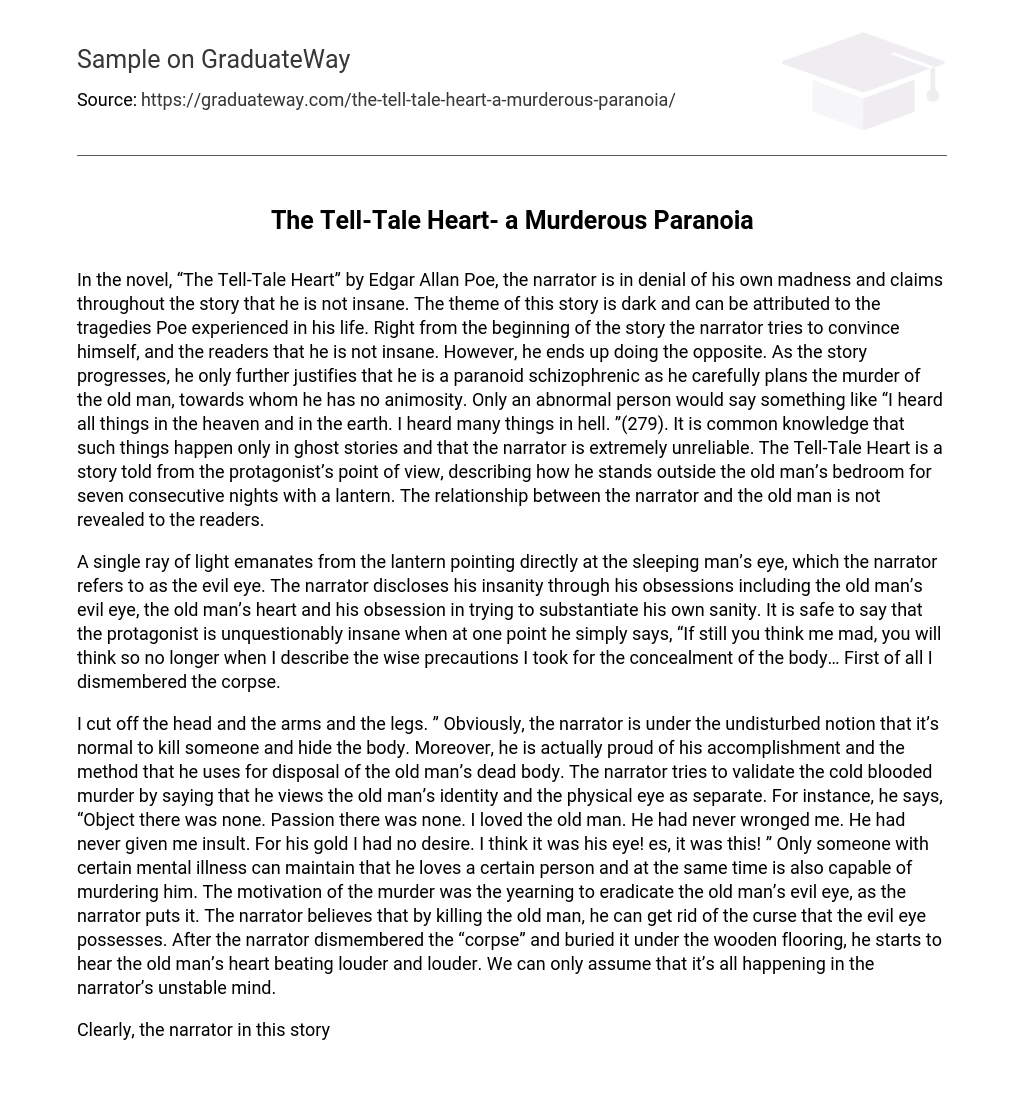In the novel, “The Tell-Tale Heart” by Edgar Allan Poe, the narrator is in denial of his own madness and claims throughout the story that he is not insane. The theme of this story is dark and can be attributed to the tragedies Poe experienced in his life. Right from the beginning of the story the narrator tries to convince himself, and the readers that he is not insane. However, he ends up doing the opposite. As the story progresses, he only further justifies that he is a paranoid schizophrenic as he carefully plans the murder of the old man, towards whom he has no animosity. Only an abnormal person would say something like “I heard all things in the heaven and in the earth. I heard many things in hell. ”(279). It is common knowledge that such things happen only in ghost stories and that the narrator is extremely unreliable. The Tell-Tale Heart is a story told from the protagonist’s point of view, describing how he stands outside the old man’s bedroom for seven consecutive nights with a lantern. The relationship between the narrator and the old man is not revealed to the readers.
A single ray of light emanates from the lantern pointing directly at the sleeping man’s eye, which the narrator refers to as the evil eye. The narrator discloses his insanity through his obsessions including the old man’s evil eye, the old man’s heart and his obsession in trying to substantiate his own sanity. It is safe to say that the protagonist is unquestionably insane when at one point he simply says, “If still you think me mad, you will think so no longer when I describe the wise precautions I took for the concealment of the body… First of all I dismembered the corpse.
I cut off the head and the arms and the legs. ” Obviously, the narrator is under the undisturbed notion that it’s normal to kill someone and hide the body. Moreover, he is actually proud of his accomplishment and the method that he uses for disposal of the old man’s dead body. The narrator tries to validate the cold blooded murder by saying that he views the old man’s identity and the physical eye as separate. For instance, he says, “Object there was none. Passion there was none. I loved the old man. He had never wronged me. He had never given me insult. For his gold I had no desire. I think it was his eye! es, it was this! ” Only someone with certain mental illness can maintain that he loves a certain person and at the same time is also capable of murdering him. The motivation of the murder was the yearning to eradicate the old man’s evil eye, as the narrator puts it. The narrator believes that by killing the old man, he can get rid of the curse that the evil eye possesses. After the narrator dismembered the “corpse” and buried it under the wooden flooring, he starts to hear the old man’s heart beating louder and louder. We can only assume that it’s all happening in the narrator’s unstable mind.
Clearly, the narrator in this story is mentally ill and he hears things that don’t exist. There was no real motive for committing the murder itself in the first place. Obsessions can affect people in different ways and it sometimes makes them do crazy lunatic things very much like the narrator in this story. In conclusion, the narrator’s disavowal of his insanity is itself haunting.
Works Cited
Poe, Edgar Allan. “The Tell-Tale Heart. ” Literature: An Introduction to Fiction, Poetry, Drama, and Writing. Ed. X. J. Kennedy and Dana Gioia. 5th Compact ed. New York: Longman, 2007. 279-82.





